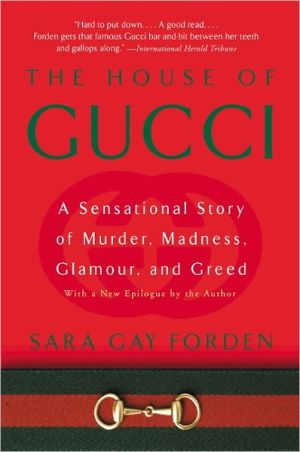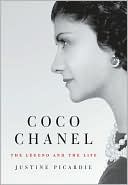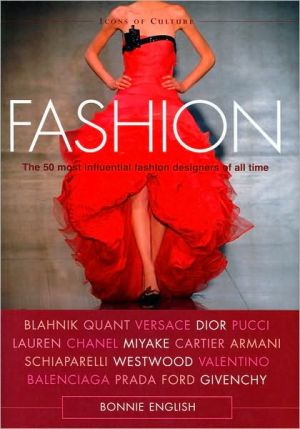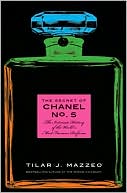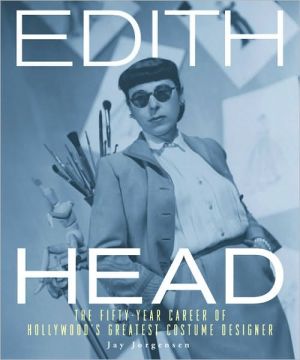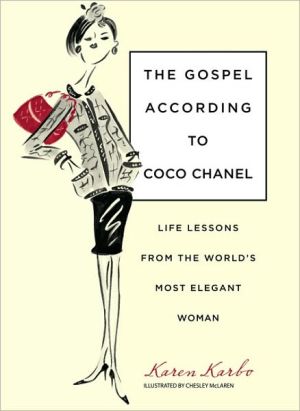House of Gucci: A Sensational Story of Murder, Madness, Glamour, and Greed
Did Patrizia Reggiani murder her ex-husband, Maurizio Gucci, in 1995 because his spending was wildly out of control? Did she do it because her glamorous ex was preparing to marry his mistress, Paola Franchi? Or is there a possibility she didn't do it at all?\ In this gripping account of the ascent, eventual collapse, and resurrection of the Gucci dynasty, Sara Gay Forden takes us behind the scenes of the trial and exposes the passions, the power, and the vulnerabilities of the greatest...
Search in google:
Did Patrizia Reggiani murder her ex-husband Maurizio Gucci in 1995 because his spending was wildly out of control? Did she do it because her glamerous ex was preparing to marry his mistress Paola Franchi? Is there a chance she didn't do it at all?In this gripping account of the ascent and eventual collapse of the Gucci dynasty, Sara Forden takes us behind the scenes of the second Trial of the Century and exposes the passions, the power, and the vulnerabilities of the greatest fashion family of our times. From the day Guccio Gucci opened his modest leather goods shop in Florence in the early 1900s to the day Investscorp took control of the multimillion dollar company in 1993; from the signature horse-bit loafers and bamboo-handled bags of the '80s to the sexy, hard-edged Tom Ford designs of today, this is a riveting story of high fashion, high finance, and heartrending personal tragedy.About the Author:Sara Gay Forden is the former Milan bureau chief and business correspondent for Women's Wear Daily. The daughter of an American diplomat, she lives in Milan with her Italian husband and young daughter.Teri AginsFashion has never been so dramatic — and dangerous. The saga of three generations of the Gucci family opens with an execution-style murder in Milan and penetrates the world of one of the hottest fashion labels of our time. Fashion insider Sara Forden spins the tale of how a bunch of greedy, bickering Guccis lost control of the empire that made GG synonymous with loafers.
A Death\ At 8:30 A.M. on Monday, March 27, 1995, Giuseppe Onorato was sweeping up the leaves that had blown into the entryway of the building where he worked. He had arrived at eight o'clock that morning, as he did every weekday, his first task being to swing open the two great wooden doors of the building at Via Palestro 20. The four-story Renaissance-style building housed apartments and offices and stood in one of the most elegant neighborhoods in Milan. Across the street, amid tall cedars and poplars, stretched the clipped lawns and winding paths of the Giardini Pubblici, an oasis of foliage and serenity in a smoggy, fast-paced city.\ Over the weekend, a warm wind had blown through the city, clearing the ever-present cap of smog and blowing the last dried leaves from the trees. Onorato had found his entryway littered with leaves that morning and hurried to sweep them up before people started coming in and out of the building. His military training had instilled in him a strong sense of order and duty, although it hadn't broken his spirit. Fifty-one years old, he was always neatly dressed and impeccably groomed, his white mustache perfectly trimmed, his remaining hair clipped close. A Sicilian from the town of Casteldaccia, he had come north like so many others looking for work and a new life. Following his retirement from the army in 1980 after fourteen years as a noncommissioned officer, Onorato had decided to settle in Milan, where he worked for several years at various odd jobs. He took the doorman's post on Via Palestro in 1989, traveling back and forth on a small motor scooter from the apartment where he lived with his wife in the northwestsection of the city. A gentle man with clear blue eyes and a sweet, shy smile, Onorato kept the entryway immaculate. The six highly polished, red granite steps that rose immediately inside the massive front doorway, the sparkling glass doors at the top of the steps, and the shiny stone floors of the foyer reflected his efforts. At the back of the foyer, Onorato had a small glassed-in cubicle made of wood with a table and chair, but he rarely sat there, preferring to keep busy with his chores. Onorato had never quite felt at ease in Milan, which had offered him work but little else. He was sensitive to the bias many northern Italians have against meridionali, or people from the south, and it took little more than a glance to make him bristle. He never talked back and he obeyed his superiors as he had learned to do in the army, but he refused to bow his head.\ "I am just as worthy as the next man," Onorato would think, "even if he is rich or from an important family."\ Onorato glanced up as he swept and noticed a man across the street. Onorato had seen the man immediately that morning upon opening the two great doors. The man had been standing behind a small green car parked perpendicular to the street with its nose facing the Giardini Pubblici, away from Onorato's building. Usually cars lined the curbs of Via Palestro, one of the few streets in downtown Milan that still had free parking. The cars parked at an angle, facing the curb. It was early, and the car was still alone. The license plate caught Onorato's eye because it was hanging so low it almost touched the ground. Onorato wondered what business the man had at that hour. Clean shaven and well dressed, the man was wearing a light brown overcoat. He kept looking down the street toward Corso Venezia as though expecting someone. Absently stroking his own balding crown, Onorato noticed with some envy that the man had a full head of dark, wavy hair.\ Ever since a bomb had gone off up the street in July of 1993, he had kept his eyes open. With a blast that shook the city, a car packed with dynamite had exploded, killing five people and destroying the Padiglione d'Arte Contemporanea, the modern art museum, which collapsed in a rubble of cement, steel girders, and dust. That same evening, another bomb had exploded in Rome, damaging San Giorgio Velabro, a church in the city's historic center. The bombs were later linked to an earlier explosion in Florence on Via dei Georgofili that also killed five people, wounded thirty, and destroyed dozens of pieces of artwork that were stored in the building above the explosion. The bombings were later traced to a Sicilian mafia boss, Salvatore "Toto" Rüma, who bad been arrested earlier that year for the 1992 murder of Italy's top mafia prosecutor, Giovanni Falcone. Rüna had ordered the bombings of some of Italy's most precious cultural monuments in retaliation for his arrest. He was later convicted for both the Falcone murder and the bombings and is currently serving two life sentences. The DIGOS, Italy's political police, which has a specific mandate to move against acts of terrorism, had interviewed all the portinai, or doormen, in the Via Palestro neighborhood. Onorato had told them he'd seen a suspicious-looking camper parked near one of the gates to the park that day. From then on, he made little notes on a pad he kept in his cubicle to record anything he saw that seemed unusual.\ "We are the eyes and ears of this neighborhood," Onorato explained to one of his army buddies who often stopped by for coffee. "We know who comes and goes and it's part of our job to observe."\ Onorato turned and pulled the right-hand door toward him in order to sweep the last few leaves out from behind it. Stepping behind the door, leaving it half-closed, he heard quick footsteps on the stairs and a familiar voice call out to him: "Buongiorno!"\ Onorato turned to see Maurizio Gucci, who had offices upstairs on the first floor, sprinting up the entry stairs with his usual energy, his camel coat swinging...
\ From Barnes & NobleThe Barnes & Noble Review\ Money, mayhem, murder, and a sharp-looking handbag: This is the history of Gucci in a nutshell. Between the company's birth as a small leather goods concern in 1921 and its just-in-time reinvention as a cutting-edge fashion house in the '90s, the story of Gucci rivals any soap opera for drama and turbulence. Sara Gay Forden's The House of Gucci delivers, as promised, "a sensational story of murder, madness, glamour, and greed," liberally laced with gossipy asides that will intrigue even the most jaded fashionista. \ Forden, a longtime resident of Milan and observer of the fashion scene, airs the Gucci family's dirty laundry with almost as much verve as they themselves showed. The business and the family were dominated -- and eventually torn apart -- largely by the flamboyant and volatile Aldo, Rodolfo, and Maurizio Gucci. Their story is a compelling one, featuring stretches of astonishing creativity and cooperation punctuated by periods of all-out warfare. Tempestuous relationships were as much a Gucci specialty, within the company and the family alike, as the trademark horse-bit loafer, and Forden's account of their internecine battles is juicy and gripping.\ At stake was an enormously lucrative business that had been dangerously diluted by financial malfeasance, gross mismanagement, and promiscuous licensing. Maurizio's struggle to retain control of the company against the hostility of the rest of the Gucci clan, while handicapped by his own managerial limitations, is the stuff of tragedy, if tragedy can ever be said to lope along carrying an expensive set of custom-dyed crocodile luggage.\ After Gucci's acquisition by an investment group, the story of the company becomes less histrionic, but the ascent of design director Tom Ford, and Gucci's subsequent renaissance as a major fashion player, make for an absorbing, if less turbulent, story. Bringing Gucci into the cutthroat fashion world of the '90s was apparently no small feat, and Forden captures the inventiveness and bravado that were necessary to pull it off.\ The more bloodthirsty reader will be relieved to learn that the story returns to tumult once more when Forden explores the murder of Maurizio, the last Gucci to run the company, at the command of his estranged wife Patrizia. It's the final fillip that makes The House of Gucci downright riveting: luxury goods, family strife, and a crime of passion make for a wickedly good read.\ Julie Robichaux is a freelance writer; she lives in New York City.\ \ \ \ \ \ Teri AginsFashion has never been so dramatic — and dangerous. The saga of three generations of the Gucci family opens with an execution-style murder in Milan and penetrates the world of one of the hottest fashion labels of our time. Fashion insider Sara Forden spins the tale of how a bunch of greedy, bickering Guccis lost control of the empire that made GG synonymous with loafers.\ \ \ Publishers WeeklyThe brutal 1995 murder of Maurizio Gucci, the grandson of the Gucci company founder, serves as entree into the history of one of the world's most glamorous fashion houses. The author, a longtime fashion writer for Women's Wear Daily, wonderfully describes how Guccio Gucci learned, as a low-level employee at London's Savoy hotel in the 1890s, that luggage functions as a symbol of "affluence and taste," and then went on to create opulent leather goods that caught the world's eye. Forden traces how Guccio--and his descendants--used charisma and intuition, rather than trained business acumen, to create the handbag dynasty. The "Gucci concept," a group of colors and designs largely derived from horse stables, didn't hurt either. But much of the book is devoted to the in-fighting that developed among Guccio's sons and grandsons. This in-fighting as well as the Guccis' inability to adapt to increased competition, professionalize their management and maintain the value of their brand name eventually caught up with them. In fact, Maurizio, having risen to the top of the company in the 1980s by using outside investors to depose his uncle, was eventually bought out in 1993, leaving no family members in the company's top management. (Forden does explain how the Gucci company has since made a comeback.) The book is, at times, too detailed about fashion history and techniques, and some may find the author's use of dramatic re-creations annoying. Nevertheless, he offers an intriguing view of one of the families that helped to create 20th-century style and business. Photos not seen by PW. (Sept.) Copyright 2000 Cahners Business Information.\ \ \ \ \ Library JournalFor this cautionary tale about the Gucci dynasty, former journalist Forden (Women's Wear Daily) draws on numerous interviews, articles, and books, in particular Gerald McKnight's A House Divided (LJ 12/87). She opens with a history of the company, a Florentine "mom-and-pop" leather-goods shop started by Guccio Gucci in the early 1900s that evolved into a global fashion empire. Over the years, the Guccis had their ups and downs. In the company's heyday of the 1950s and 1960s, products bearing the Gucci name were status symbols. But the family was plagued by infighting, lawsuits, product imitations, mismanagement, greed, and tragedy. By the late 1980s, the business was in a slump, and 50 percent of the company was sold to a Bahrain-based investment group. Forden's story ends with the trial of Patrizia Reggiani, accused in a plot that killed her ex-husband, Maurizio Gucci, in March 1995. Forden is a skilled researcher and a good storyteller. Recommended for fashion collections.--Bellinda Wise, Nassau Community Coll. Lib., Garden City, NY Copyright 2000 Cahners Business Information.\\\ \ \ \ \ Francine ProseThe story of this rise and fall–this metamorphosis and reversion–is entertainingly told in The House of Gucci. Sara Gay Forden’s "sensational story of murder, madness, glamour, and greed" provides all the guilty pleasures and none of the usual drawbacks of the sex-and-shopping novel. For one thing, it’s more lucidly written than your average Judith Krantz or Jackie Collins heavy-breather. For another, it happens to be nonfiction, so you can’t blame the writer for the sort of melodramatic, unlikely plot turns that might make you suspect a novelist of having learned to write by watching reruns of Dynasty and Dallas. You can only chalk up the wildly improbable characters and events (for instance, the exorcist summoned to cleanse the bad vibes from the Creole, the newly purchased yacht on which Stavros Niarchos’ first and second wives had committed suicide; or the "coincidence" of the silver handcuffs that appeared in Gucci shop windows worldwide after Patrizia was convicted) to the mysterious workings of Destiny, and to the fact that truth is way stranger than fiction.\ —The New York Observer\ \ \ \ \ Sanders...a tantalizing read.\ —People Magazine\ \ \ \ \ The EconomistMs. Forden has whipped up a mixture of family drama and high finance into a tasty and complex narrative. Through exhaustive research and access to everyone that matters—she even corresponded with the jailed Patrizia—she takes readers right inside the Gucci boardroom. This is a business book you will zip through like a novel.\ \
